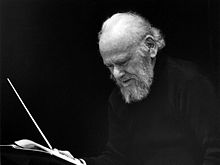Ralph Shapey

Ralph Shapey (March 12, 1921 – June 13, 2002) was an American composer and conductor. He is well-known for his work as a composition professor at the University of Chicago, where he founded and directed the Contemporary Chamber Players. Shapey was a MacArthur Fellow in 1982.
Although Shapey's style is characterized by angularity, irony, and technical rigor, it eschews the pointillism, anti-emotionalism, and detached austerity of much twelve-tone music. His work's insistence instead on sweeping gesture, frenetic passion, rhythmic vitality, lyrical melody, and dramatic arc recall Romanticism. Shapey was dubbed by critics Leonard Meyer and Bernard Jacobson as a "radical traditionalist," which pleased him immensely -- he held a deep respect for the masters of the past, whom he regarded as his finest teachers.
The French-American composer Edgard Varèse was among Shapey's most important influences. Both composers shared a fascination with unusual sonorities, counterpoint masses, and the outer extremes of pitch space. The coordination of static "sound blocks" in Shapey's music also reminds one of another great French composer, Olivier Messiaen, though Shapey reportedly found Messiaen's music saccharine and maudlin. Shapey also studied with Stefan Wolpe.
Although comparisons are useful, Shapey's compositional voice is undoubtedly personal and distinctive. Many listeners would call his music "atonal," but Shapey himself denied the label. He considered himself a tonal composer, and indeed his work, though couched in a highly dissonant harmonic idiom rich in interval classes 1 and 6, does adhere to certain organizational features of tonal music, including pitch hierarchy and object permanence.
In 1992 the Pulitzer Prize for Music jury, which that year consisted of George Perle, Roger Reynolds, and Harvey Sollberger, selected Shapey's "Concerto Fantastique" for the award. However, the Pulitzer Board rejected that decision and choose to give the prize to the jury's second choice, Wayne Peterson. The music jury responded with a public statement stating that they had not been consulted in that decision and that the Board was not professionally qualified to make such a decision. The Board responded that the "Pulitzers are enhanced by having, in addition to the professional's point of view, the layman's or consumer's point of view," and they did not rescind their decision. [1]
Shapey created a body of over 200 works, many of which have been published by Presser. Presser also offers his textbook A Basic Course in Music Composition, written after over fifty years of teaching the subject. Recordings of Shapey's music are available on the CRI, Opus One, and New World labels. Shapey's works have been catologued by Dr. Patrick D. Finley in A Catalogue of the Works of Ralph Shapey, published by Pendragon Press
His students include Gerald Levinson, Robert Carl, Gordon Marsh, Michael Eckert, Matt Malsky, Lawrence Fritts, James Anthony Walker, Frank Retzel, Jorge Liderman, Jonathan Elliott, Deborah Drattell, Ursula Mamlok, Shulamit Ran, Terry Winter Owens, and a very broad and exceptional list of others.
The composer Robert Black was particularly influenced by him, and as a conductor he also premiered Shapey's Three for Six.
Statement by Ralph Shapey about his work

“[A] 'radical traditionalist' is what I’ve been called. My music combines two fundamentally contradictory impulses–-radical language and romantic sensibility. The melodies are disjunct and dissonant; they contain 'atonal' harmonies and extremes in register, dynamics, and textural contrast. Yet the musical structures are grandly formed and run the gamut of dramatic gestures. Like the Romantics, I conceive of art in a deeply spiritual way. A great work of art transcends the immediate moment into a world of infinity.
My credo is: 1) The music must speak for itself. 2) Great art is a miracle. 3) What the mind can conceive will be done."
Sources
- Carl, Robert "Radical Traditionalism". Liner notes to Ralph Shapey - Radical Traditionalism. New World Records.
External links
- Presser Online Composer Information - Ralph Shapey
- Bierce Library at University of Akron: Smith Archives - Composer Profile of Ralph Shapey
- University of Chicago News Office - Obituary for Ralph Shapey
- The Musical Times - In Memoriam Ralph Shapey
- Art of the States: Ralph Shapey 21 Variations (1978) performance, essay, and podcast by pianist David Holzman
